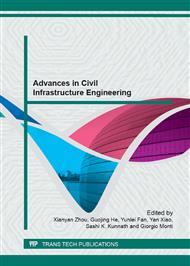p.389
p.394
p.399
p.404
p.411
p.417
p.423
p.429
p.434
Study on the Performance and Application of High Performance Pavement Portland Cement Concrete
Abstract:
Because of some drawbacks including low strength, poor dimensional stability, low abrasion resistance, easy to crack and other shortcomings, Portland cement concrete was limited to use as a dominant pavement material in highway construction. This paper studied the feasibility of making high performance pavement concrete by adding 20-40% of high-quality composite ultra-fine fly ash (CUFA) technology to achieve high-performance of concrete roads have been studied. The test results indicated that: with cementitious material content of 360~400 kg/m3 and CUFA content of 20% ~ 40%, adding CUFA improved the workability of concrete significantly; in the meantime, the 28d compressive strength was as high as 50 MPa, and the later strength of concrete continued growing. The designed concrete satisfied the requirements of opening to traffic after 3 days after the construction and heavy and extra heavy traffic in 28 days. The durability, especially the abrasion resistance, and the crack-resistance were improved significantly. The designed pavement concrete not only had a good compressive performance for practical engineering but also had good technical, economic, social and environmental benefits.
Info:
Periodical:
Pages:
411-416
Citation:
Online since:
January 2013
Authors:
Price:
Сopyright:
© 2013 Trans Tech Publications Ltd. All Rights Reserved
Share:
Citation:


